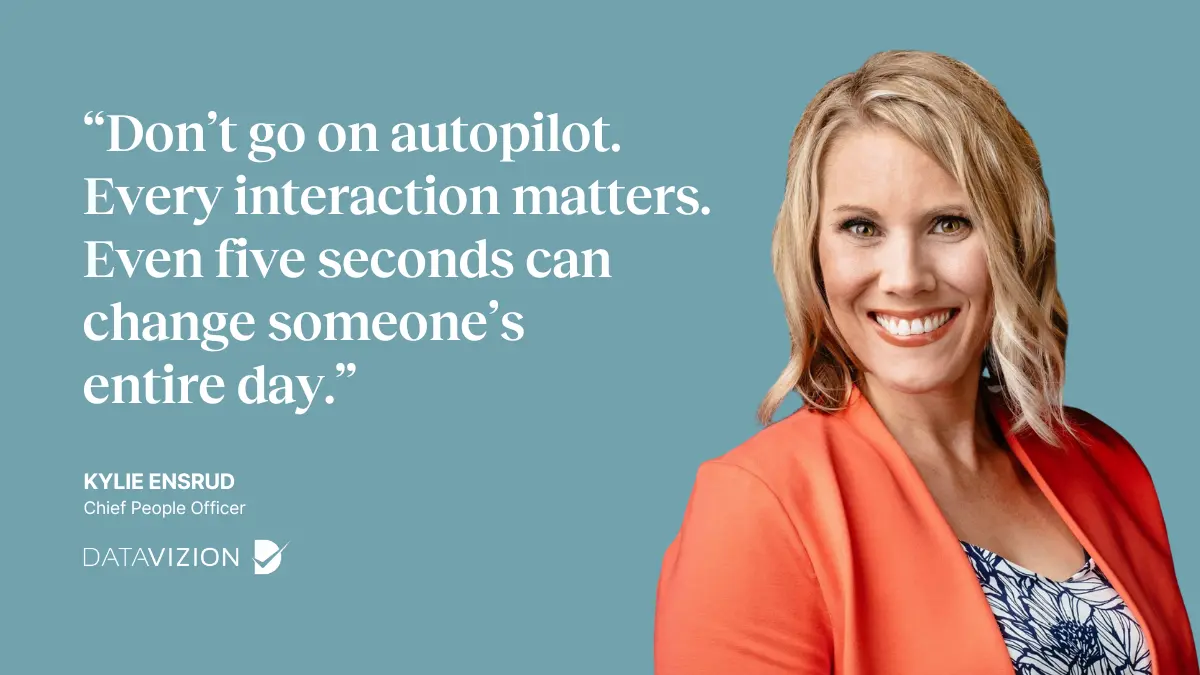What is transformational leadership? Real-world lessons from an HR leader
.webp)
Transformational leadership is no longer optional; it’s essential for engagement, retention, and workplace trust. In this recap of our Missing Chapters conversation with Kylie Ensrud, Chief People Officer at DataVision, we explore why leaders often default to transactional habits, what transformational leadership looks like in practice, and how HR teams can help managers build authentic, human-centered connections.
Today’s leaders are under growing pressure to move beyond surface-level interactions. Building transformational connections, rather than transactional exchanges, has become essential for engagement, retention, and performance. Yet only 23% of employees worldwide feel engaged at work, and disengagement costs the global economy $8.8 trillion annually. Clearly, engagement isn’t just an HR buzzword. It’s a business crisis. And transformational leadership is one of the most powerful ways to close that gap.
In a recent Missing Chapters conversation with Kylie Ensrud, Chief People Officer at DataVizion, we explored why leaders so often default to transactional habits, what it looks like to build transformational connections instead, and how HR teams can equip managers to foster the kind of trust and authenticity employees are craving.
What is transformational leadership?
Transformational leadership goes beyond task-focused conversations to foster trust, encourage collaboration, and support employee development. Rather than relying on authority, transformational leaders create environments where employees feel heard, respected, and motivated to perform at a higher level.
Key qualities include:
- Emotional intelligence
- Active listening
- A commitment to helping others grow
- Consistent authenticity
This kind of leadership is no longer optional. It’s a strategic imperative.

Why do leaders default to transactional leadership?
Transactional leadership is defined by quick, tactical exchanges: asking for KPIs, updates, or status reports without deeper engagement. It’s efficient, outcome-driven, and emotionally neutral.
But why do leaders default here? According to Kylie, the answer lies in brain science. Our brains are wired to conserve energy. Emotional conversations, active listening, and empathy all demand cognitive effort. When time is tight and priorities stack up, our brains nudge us toward easier, more transactional interactions.
The problem? Easy isn’t always better, especially when connection, trust, and team performance are at stake.
How can transformational leadership change outcomes?
Transformational leadership changes outcomes not through grand gestures, but through consistent, authentic moments. Kylie shared two pivotal examples from her career that show how leaders can go deeper:
By listening to hard feedback
Early in her career, Kylie’s mentor pulled her aside and told her she was dominating conversations and not listening. The feedback was painful, but it reshaped her leadership approach. By learning to pause, listen, and engage more intentionally, she built stronger relationships and earned a promotion soon after.
By rebuilding trust in difficult relationships
Later in her career, Kylie struggled with a CEO whose style felt abrasive and transactional. Journaling helped her reflect on her own defensiveness and realize trust was missing. Over time, she leaned into humility and consistency, transforming their relationship into one of deep respect and collaboration.
Takeaway: Transformational leadership happens in the everyday, by choosing to listen, reflect, and show up with intention.
What role does vulnerability play in transformational leadership?
Vulnerability is often misunderstood. It’s not oversharing. It’s being real enough that others feel safe doing the same.
It looks like:
- Admitting when you don’t have the answer
- Asking for support without undermining authority
- Leading with consistent authenticity, not perfection
When leaders show grounded vulnerability, they create cultures of trust, safety, and honest feedback.

How do you know when you’re disconnected?
Leaders often slip into transactional mode without realizing it. Kylie pointed out that the first step toward change is simply recognizing the warning signs. Here are four red flags that may indicate you’ve drifted into disconnection:
Emotional disengagement
If you find yourself feeling numb, checked out, or indifferent during conversations, that’s a signal your engagement is slipping. Leaders don’t need to be emotionally “on” every moment of every day, but when interactions with your team consistently leave you detached or unmoved, it’s a sign that connection and trust are weakening.
Physical defensiveness
The body often reacts before the mind catches up. Tight shoulders, a spike in blood pressure, or the urge to shut down in a meeting can all be physical cues that you’re on the defensive. Instead of dismissing these sensations, treat them as early warning signals that the relationship or discussion needs deeper attention.
Lack of curiosity
When you stop asking questions (or worse, stop caring about the answers) you’ve likely slipped into a transactional mindset. Leaders who lose curiosity about their teammates’ successes, challenges, or ideas miss opportunities to build trust and spark innovation. Disinterest is one of the clearest indicators that engagement has eroded.
Autopilot interactions
Defaulting to surface-level check-ins or rushing through meetings without genuine dialogue may keep the wheels turning, but it leaves little room for transformational connection. If your conversations are purely tactical, focused only on numbers, deadlines, or quick updates, you’re likely operating on autopilot.
Catching these cues early allows leaders to course-correct before disconnection erodes trust.
Why does manager engagement matter so much?
Manager engagement dropped to 27% in 2024, with steepest declines among young and female managers. That matters because 70% of team engagement can be attributed to the manager.
When leaders disengage, their teams feel it. Transactional leadership alone, focused purely on tasks, can’t sustain engagement. Transformational leadership is how we reverse this trend.
How can leaders train their brains for transformation?
While our brains crave efficiency, transformational leadership is a skill, and it’s one that can be built over time. Kylie recommends five simple tactics:
- Leadership journaling: Track emotional reactions, blind spots, and patterns
- Visual reminders: Write cues like “LISTEN” to stay present
- Micro-habits & 1% improvements: Focus on one small shift per day
- Intentional triggers: Use Post-its or phrases to interrupt autopilot
- Allowing grace: Remember growth takes time and discomfort signals change
“Leadership growth is just like building muscle — you don’t run a marathon tomorrow. You start with 1% better every day.” — Kylie
How can HR leaders build a culture of connection?
Transformational leadership doesn’t require hours of one-on-ones or elaborate retreats. It’s built through consistent, intentional moments:
- Build trust through consistency: Small commitments matter most during busy times
- Prioritize trust early: Early investments prevent later breakdowns
- Tailor support: Meet people where they are — autonomy for some, coaching for others
- Ask better questions: Go beyond status updates. Try:
- “What’s one thing you’re excited about this week?”
- “What’s feeling heavy for you right now?”

Transformational leadership isn’t about being perfect. It’s about being present.
By committing to daily habits of reflection, empathy, and connection, HR leaders and managers can move beyond transactional routines and build cultures where people feel heard, valued, and inspired to thrive. The path is simple: aim to be 1% better every day.
Watch the full Missing Chapters conversation on transformational leadership with Kylie Ensrud here, and join Nava’s HR community, Change Agents, to continue learning with peers across the industry.




.webp)

.webp)